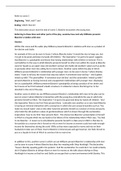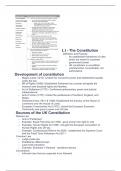University of Amsterdam
Faculty of Law
What To Make of the ECT?
The Legal Dilemma between Moving Forward, and Going Backwards
B.M. van den Biggelaar
| 14126400
Under the supervision of mr. K. van Loo
June 2024
,Table of Contents
1. INTRODUCTION .............................................................................................................................................. 3
1.1. BACKGROUND AND RATIONALE ..................................................................................................................... 3
1.2. RESEARCH QUESTION..................................................................................................................................... 4
1.3. RESEARCH METHODOLOGY ............................................................................................................................ 4
1.4. SET-UP ........................................................................................................................................................... 4
2. WHAT IS THE ECT?......................................................................................................................................... 5
2.1. THE ORIGINAL PURPOSE OF THE ECT ............................................................................................................ 5
2.2. THE ECT IN THE CURRENT ECONOMIC AND POLITICAL CONTEXT .................................................................. 6
2.3. THE RELEVANCE OF THE ECT IN THE CONTEXT OF CLIMATE GOALS ............................................................ 7
3. THE POSSIBILITY OF THE ECT TO PROVIDE RULES FOR ENERGY SECURITY THROUGH
THE OPERATION OF AN OPEN RENEWABLE ENERGY MARKET ........................................................ 8
3.1. THE EFFECT OF THE CJEU CASE LAW ON THE ECT ...................................................................................... 8
3.2. EFFORTS TO MODERNIZE AND IMPROVE THE APPLICABILITY OF THE ECT .................................................. 10
4. ACTIONS CONTRACTING PARTIES CAN TAKE TO GUARANTEE THE PREFERRED PURPOSE
OF THE ECT ........................................................................................................................................................ 11
4.1 SUBSTANTIVE MODIFICATION OF THE ECT ................................................................................................... 12
4.1.1. THE AMENDMENT PROCESS ...................................................................................................................... 12
4.1.2. FEASIBILITY OF THE MODIFICATION OF THE ECT ..................................................................................... 12
4.2. RESOLVING THE INCOMPATIBILITY OF THE ECT WITH CLIMATE AND ENERGY GOALS THROUGH
WITHDRAWAL ..................................................................................................................................................... 13
4.3. ADDRESSING THE SUNSET CLAUSE IN CASE OF WITHDRAWAL .................................................................... 14
4.3.1. Amendment of the sunset clause.......................................................................................................... 14
4.3.2. Inter se agreement ............................................................................................................................... 15
5. CONCLUSION ................................................................................................................................................. 17
BIBLIOGRAPHY ................................................................................................................................................ 19
, 1. Introduction
1.1. Background and rationale
The Energy Charter Treaty (hereinafter ECT) is at risk as contracting parties consider
denouncing it. Critics argue the ECT's protections for fossil fuel investors conflict with modern
climate goals, such as limiting global warming to 1.5°C, as outlined in the Paris Agreement.
The protection under the ECT often results in rulings favoring fossil fuel investors,
compromising energy security.1 Spain, as an illustration, was found to be in breach of the ECT
in 18 out of 23 cases, up until 2021, despite its efforts to align with climate regulations.2
In response, many countries have announced their withdrawal because of the protection it offers
to fossil energy investors.3 The European Commission, supported by countries like the
Netherlands, proposed a coordinated European Union (hereinafter EU) withdrawal. The
Council of the European Union has finally consented to this.4 This raises questions about the
treaty's significance as progressive countries leave, while fossil fuel-dependent nations remain.
Withdrawal might ironically extend protections of the old ECT regime for fossil fuel investors
due to its “sunset clause”, binding states to old obligations for 20 years.5 This hinders states
from achieving modern energy and climate goals. Withdrawing states would still be subjected
to claims with respect to investments under the old regime of the ECT while trying to align with
climate regulations. Furthermore, withdrawal could stall the modernization process of the ECT,
which the EU spearheaded.6
Besides, the European Court of Justice (hereinafter CJEU) has ruled that intra-EU arbitration
violates EU law, as seen in the Achmea and Komstroy cases.7 The CJEU emphasized that ECT
arbitration infringes on the EU's legal autonomy, as ECT tribunals cannot refer questions to the
CJEU.8 This renders the ECT nearly inapplicable within the EU, questioning its relevance.
1
Salvatore 2021, p. 14.
2
Baldon & Dupré & Lickel 2021, p. 2.
3
Haut Conseil pour le Climat 2022, p. 2.
4
2023/0273(NLE).
5
Article 47(3) of the ECT.
6
Energy Charter Conference 2019, p. 3.
7
ECJ 6 March 2018, C-284/16, ECLI:EU:C:2018:158, para. 58 (Slovak Republic v. Achmea B.V.),
and: ECJ 2 September 2021, C-741/19, ECLI:EU:C:2021:164, para. 61-63 (Komstroy v. Moldova).
8
ECJ 2 September 2021, C-741/19, ECLI:EU:C:2021:164, para. 52 (Komstroy v. Moldova).











